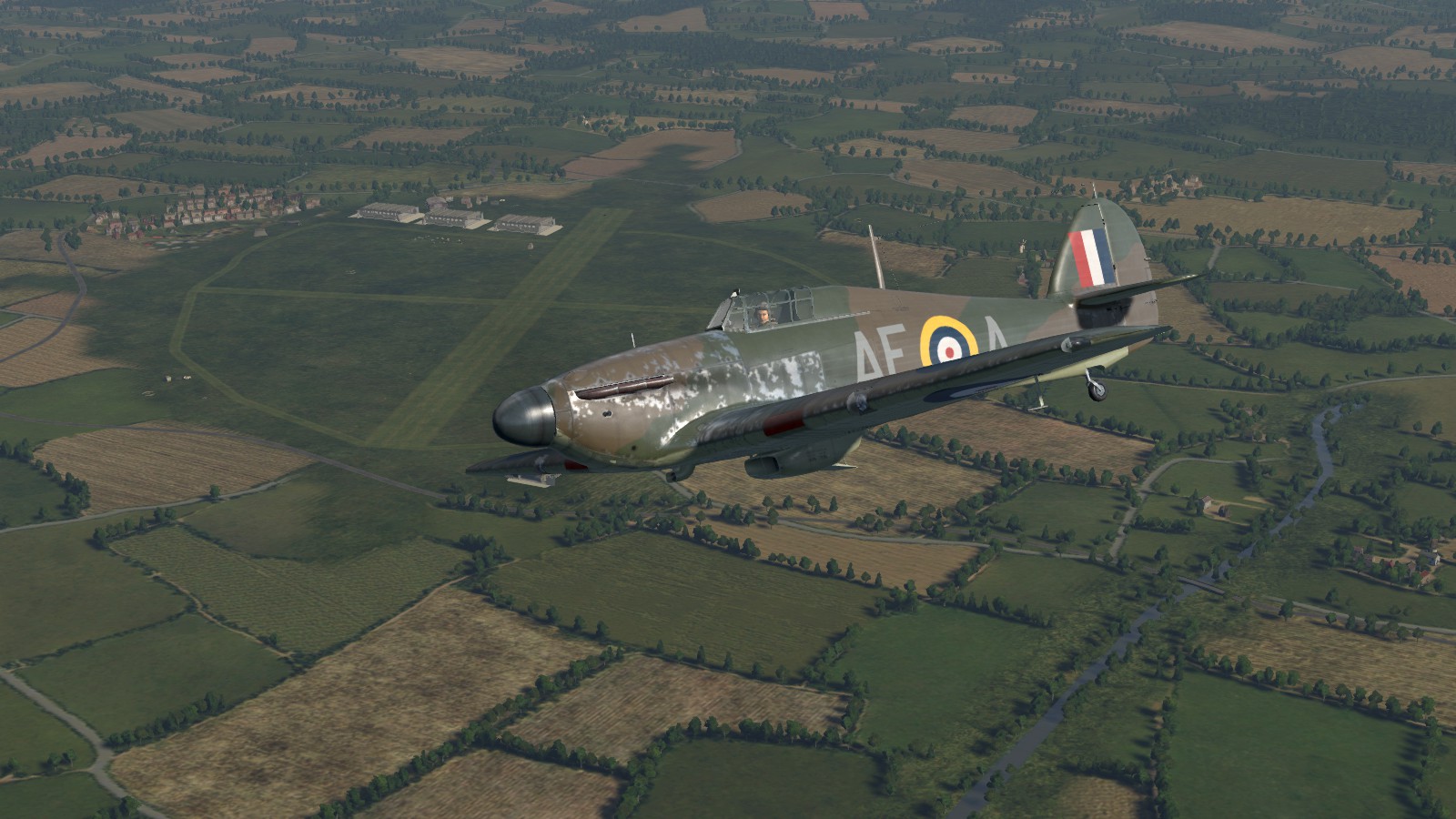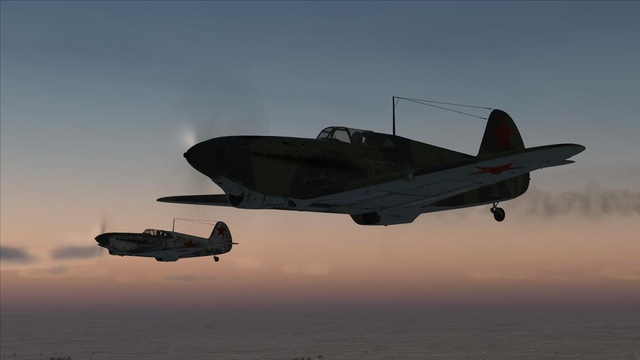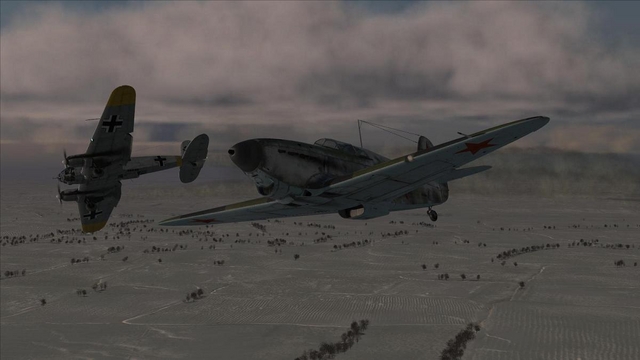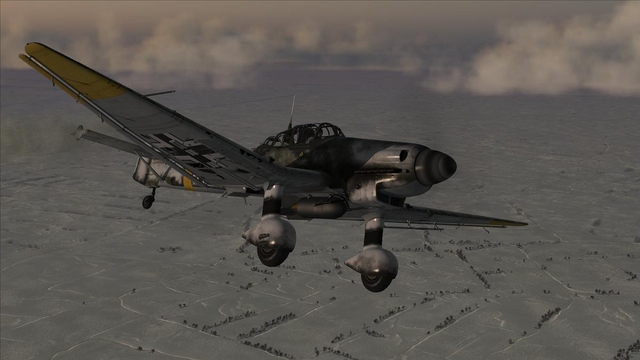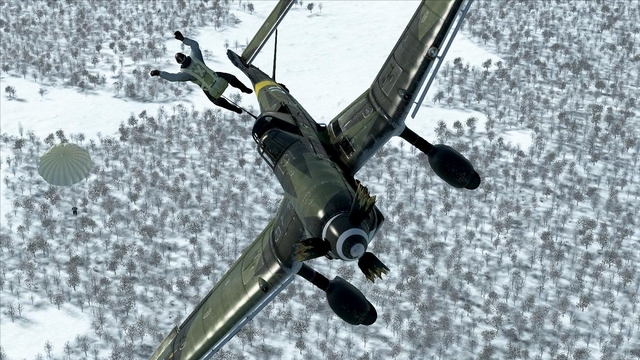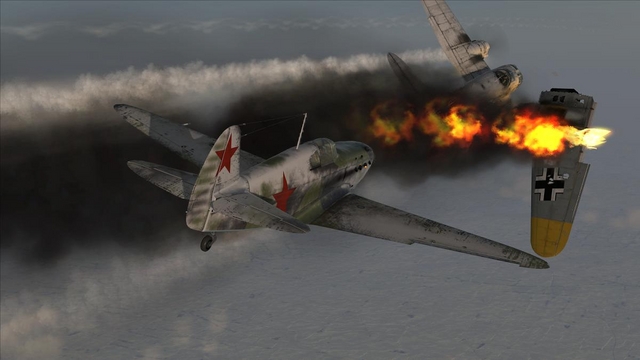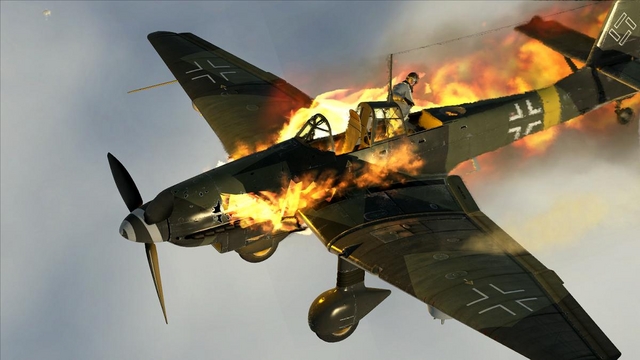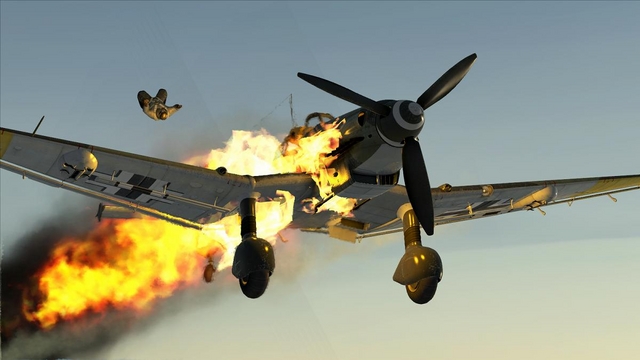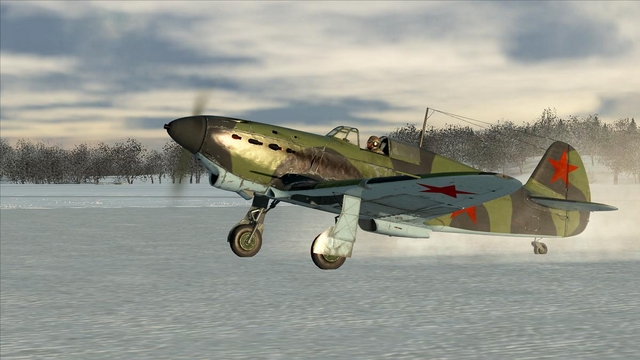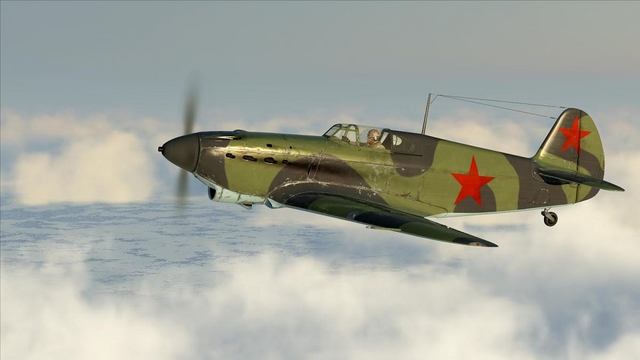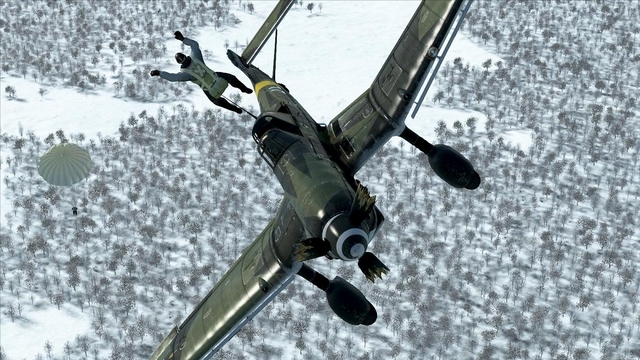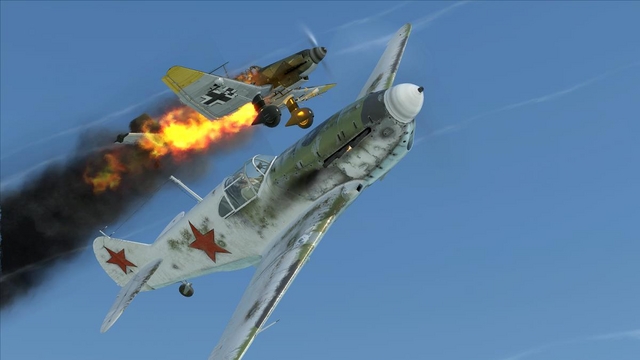-
Content count
3,749 -
Joined
-
Last visited
-
Days Won
7
Content Type
Profiles
Forums
Calendar
Gallery
Downloads
Store
Everything posted by 33LIMA
-

IL-2 Battle of Stalingrad - the CombatAce review, part 4
33LIMA replied to 33LIMA's topic in Game Reviews
Thanks Crusader; my pleasure!- 21 replies
-

IL-2 Battle of Stalingrad - the CombatAce review, part 4
33LIMA replied to 33LIMA's topic in Game Reviews
Speaking of 'haters' lists, Heinkels are now on mine. This one refused to get out of my way quickly enough, and look what happened: The BoS 'unlocks' were mostly to blame, though. I mean, I had just unlocked this 'ace' skin for my Yak. How was I supposed to know that flying with an ace's skin would make me press my attack much closer, before I broke away, too late in fact? I mean to say...!- 21 replies
-
- 1
-

-

Bf109K4, the uber plane!
33LIMA replied to streakeagle's topic in Digital Combat Simulator Series General Discussion
Interesting...how about doing a screenshot-laden mission report for the guys, Cadillac of the Skies -vs- Augsburg Eagle? Would be cool by the sound of it. -

IL-2 Battle of Stalingrad - the CombatAce review, part 4
33LIMA replied to 33LIMA's topic in Game Reviews
BoS is already there, in my book, despite all the gnashing of teeth and tearing of raiment. Next point on the Progressive Scale of Posterior Punishment would I think be 'Truly Whop Ass'; time will indeed tell. I don't know if there's a point on that particular scale after 'Truly Whop Ass', but if there is, it probably involves fire...- 21 replies
-

IL-2 sturmovik: Battle of Stalingrad - Yak-1s returning from a dusk sortie
33LIMA posted a gallery image in Member's Albums
From the album IL-2 Battle of Stalingrad
-
- il-2 sturmovik
- battle of stalingrad
-
(and 1 more)
Tagged with:
-

IL-2 Sturmovik: Battle of Stalingrad - LaGG-3 attacking a Heinkel on final approach
33LIMA posted a gallery image in Member's Albums
From the album IL-2 Battle of Stalingrad
-
- il-2 sturmovik
- battle of stalingrad
-
(and 1 more)
Tagged with:
-

IL-2 Sturmovik: Battle of Stalingrad - Ju-87D in temporary winter finish
33LIMA posted a gallery image in Member's Albums
From the album IL-2 Battle of Stalingrad
-

IL-2 Sturmovik: Battle of Stalingrad - Ju-87 goes down after a mid-air collision
33LIMA posted a gallery image in Member's Albums
From the album IL-2 Battle of Stalingrad
-

IL-2 Sturmovik: Battle of Stalingrad - LaGG-3 shoots down a Heinkel
33LIMA posted a gallery image in Member's Albums
From the album IL-2 Battle of Stalingrad
-
- il-2 sturmovik
- battle of stalingrad
-
(and 1 more)
Tagged with:
-

IL-2 Sturmovik: Battle of Stalingrad - Stuka air gunner bailing out
33LIMA posted a gallery image in Member's Albums
From the album IL-2 Battle of Stalingrad
-

IL-2 Sturmovik: Battle of Stalingrad - Stuka air gunner bails out
33LIMA posted a gallery image in Member's Albums
From the album IL-2 Battle of Stalingrad
-

IL-2 Sturmovik: Battle of Stalingrad - Yak-1 on a dusk mission
33LIMA posted a gallery image in Member's Albums
From the album IL-2 Battle of Stalingrad
-
- il-2 sturmovik
- battle of stalingrad
-
(and 1 more)
Tagged with:
-

IL-2 Battle of Stalingrad - the CombatAce review, part 4
33LIMA replied to 33LIMA's topic in Game Reviews
Fortunately, the 'real' war is much more interesting...- 21 replies
-

IL-2 Battle of Stalingrad - the CombatAce review, part 4
33LIMA replied to 33LIMA's topic in Game Reviews
I believe one of the volunteer mods became impatient with what was seen by him and some others as increasingly tedious and/or repetitive negativity. Some were caught in the crossfire, as it were, once the rounds started flying. The devs stepped in to cool it down. I think a cease fire has been ordered, though intermittent sniping may go on for some time.- 21 replies
-
Spotting for the Gunners in the LFG Roland C II! In an air war notable for the sheer variety of planes of all shapes and sizes that made it to the front, the LFG Roland C II must be one of the most distinctive, if not also one of the most attractive. 'Truely, this aircraft is a whale!' was the reaction of one of the German procurement people who came to see what they'd be getting for their reichsmarks, giving the Walfisch its enduring nick-name. But it was also one of the most advanced aircraft of its day, a compact, fast, streamlined single-bay two-seater general purpose aeroplane in a world where other such machines were bigger, slower or ungainlier…and mostly, all three. 'The best German aircraft now' was reportedly the verdict of RFC ace Albert Ball, who frequently came up against (and shot down) the type in the summer and early autumn of 1916. However, though sometimes encountered in sizeable formations in this its heyday, the Roland was produced in comparatively small numbers and its front-line service career was over by about mid-1917. Speedy in the air, it was slow and expensive to make. Its thin wings tended to warp in the harsh conditions of front-line airfields and visibility for landing was poor, resulting in many crashes or hard landings. But still, it was a notable performer for its time, whose capabilities generally matched its good looks. Many of us will know the type from the 1960s Airfix 1/72 kit, helpfully moulded in light blue plastic in imitation of the distinctive finish initially carried by the Roland. It made up into a nice model, with decent crew figures instead of the dreaded 'goggled alien' of earlier Airfix WW1 kits. One day, I will make this kit again, notwithstanding that newer versions are available. In the meantime, I can fly the Roland in simulators. I don't yet have the Rise of Flight Roland, seen here escorting my DFW C V in a recent mission... ...but I do have and like the First Eagles versions from the A Team Skunkworks. Though they have a 'Spandau' machine gun for the observer, instead of a 'Parabellum', there are a couple of interesting variants, including this one with a captured Lewis Gun fitted to fire ahead over the propeller arc, which was tried in real life: But for this mission I chose Wings Over Flanders Fields. Having flown the Roland in Over Flanders Fields, I was keen to see how I made out with this machine in the latest incarnation of this sim, with Ankor's self-shadowing mod and the new AI and landscapes of WOFF. The campaign Creating a new pilot, I tabbed throught the available German 'Bomber/recce' squadrons flying in September 1916 till I found one that flew the Roland in the British sector - WOFF still provides a better representation of the RFC order of battle, and would benefit in particular from the addition of French two-seaters more suitable for either 1916 or 1918 than the Morane L (really a 1914-15 type) and the licence-built Strutter (gone from the front by mid-1918). I ended up with Feldflieger Abteilung (Artillerie) 240, based at in Flanders. I believe the 'Artillerie' indicates that we specialise in observing for the artillery and can correct their fire using radio transmitters, one of the major jobs for two-seaters in WW1, along with photo or visual reconnaisance and to a lesser extent, bombing. Here's our roster and our operational area. Even without tabbing to the Intelligence summary, I knew that the deadliest foes we could expect to face in our sector would be DH-2 'pusher' fighters and the more modern French Nieuport scout, both types used by several RFC squadrons. With the British fighters apt to patrol up to ten to twelve miles on the German side of the Lines, I knew also that we must be prepared to meet them in the air, whatever our task would be. The mission It's 12 September 1916, and our assigned task for this morning is artillery observation. Down to the south west we must go, from our airfield at Houplin down to the trench-lines. There are no less of six of us on this operation, with myself leading the full flying strength of the staffel. When I draw an 'art obs' mission in OFF or WOFF, I generally fly to the front and orbit near any friendly artillery barrage in progress, as if I was directing the fire. It's not possible actually to call down fire onto ground targets (although after this mission I'm no longer so sure, of which, more later). If there's no artillery fire going on, I regard my radio transmitter (or the battery's receiver) as having 'gone dark' and do a bit of recce work, so that the taxpayers still get their money's worth. We have an escort, but I wasn't going to put much faith in the two obsolete Fokker Eindekkers we'd been allocated. For all I knew they were the last ones at the Front, still able to beat up a BE2c but well outclassed by any fighter we were likely to meet. My own flight would serve as my escort. I would do the virtual artillery-spotting. Knowing that formation-keeping in WOFF was considerably improved over OFF, I knew my comrades would be able to keep up quite well as I circled over the front. Anyone trying to shoot down the spotter - me - would have to get through them, first. At least, that was the theory. Here we are, lined up opposite the sheds and ready for the 'off'. I had chosen a camouflaged skin from those available in WOFF, but the rest of the flight are in the original, distinctive and rather racy light blue. I checked my controls and started up. Then I called up the Tactical Display (TAC), set its target type to 'aircraft', checked its range was suitably low (I left it at half a mile) and turned the TAC off again: it was now ready to padlock air targets, when turned on again. I didn't expect to do too much (if any) dog-fighting on this mission but if I had to break formation and fight individually, I decided I was going to make good use of my forward-firing MG, relying on the observer to cover my tail. Which is more or less how it came to pass. But that lay in the furture. I roared off the airfield and tried some gentle turns before setting course for the Front and throttling back to allow my flight to catch up. I found the ailerons deceptively light and the rudder heavy. It was easy to under-bank and slip outwards, or worse still, over-bank and find yourself in a nasty side-slip, if you didn't give her plenty of top or bottom rudder. This was nearly to be my undoing. But that, too, lay in the future. For now, I watched my flight catch up from astern. One of them took several minutes, during which time I saw two aircraft fly past overhead - the two Fokkers, I supposed. This was the only time I saw them, as it turned out. At at last we were all in a nice diamond formation. I opened the throttle wide and I began to climb, maintaining forward pressure on the stick to stop my tail heavy plane's nose from rising too much. All around us, thin clouds loomed, slipped past below, beneath or beside us, then loomed ahead again. I spent a little time admiring and exploring my plane, inside and out, between navigating and scanning the skies. Visibility downwards was, as expected, not good, but in every other direction, I had a superb view, unobstructed by the usual high-mounted biplane upper wing. Looking behind, the sight of my flight tucked in behind me inspired confidence…to much, perhaps, I thought, remembering Albert Ball's opinion that such formations were easier to surprise as the aircrew tended to feel a false sense of security and relax. On we went. Climb rate was less than stellar and we were not far above five thousand feet as we came up the the trench-lines. Our Fokker escorts were nowhere to be seen and I decided I wasn't going to hang about looking for them. I was at a respectable height for artillery observation and was now at the Front, where lay our targets. I leveled off and throttled back slightly. I had arrived at the war. Approaching the area over the Lines where we were tasked with spotting for the Gunners, I turned on the Tactical Display to get a navigation check. Instead, I got a surprise. In fact, I got two surprises. First, knowing that I was headed roughly in the direction of my target area, I was startled to notice that the pale blue line showing the path to my next waypoint, instead of pointing up, straight ahead, had slewed around to my left rear. If that wasn't strange enough, the text displayed beneath the TAC itself was telling me that it was high time to go home. In fact, not even home - to the nearest airfield. Had I inadvertently skipped a waypoint? No, I was fairly sure I had done no such thing. My true objective still lay ahead. Who's leading this mission, anyway - me or the Tactical Display? Pilots in the German Air Service may often be mere NCOs but while I may have to take orders from my commissioned observer - my own alter ego, anyway - I'm certainly not at the beck and call of an on-screen visual aid. Sod that, I thought. On we go. Actually, the TAC was trying to be helpful. Looking behind, the reason for the device's caution was not hard to see. An aircraft was slicing into our formation from our left rear. And though I didn't notice it at the time, three other aircraft were below and behind us to the right. My initial reaction, seeing just the one presumed enemy attacking, was that I'm not going to break formation and get distracted from my objective for the sake of one aggressive Englishman. Unfortunately, those on the right of my formation didn't agree that staying together and meeting the enemy with massed fires was the best bet. That side of my formation broke up rapidly, as Rolands wheeled off and after the Nieuport. All very commendable perhaps and it certainly seemed to put off the foe-man, who turned away. I now had a decision to make, and I needed to make it immediately, before the passage of time removed one of my options. I could hold my course to the objective, with what looked to be two remaining flight-mates. Or I could turn us back to join the battle, keeping my formation, if not intact, then together; and resuming my progress to the objective when the battle had been won. Keeping to my present course seemed to comply with the Master Principle of War - Selection and Maintenance of the Aim...but at the expense of one nearly as important - Concentration of Force. Incidentally, contrary to what John Keegan said in 'The Face of Battle', these principles, far from being thought old-fashioned, were taught at Sandhurst in the late 1970s. Anyhow I had read too many accounts - Trafalgar, for one - of forces that are (or get) split up, then being defeated in detail, even by numerically weaker enemies. So I turned back to join the fight. By this point I had realised there was more than one enemy aircraft. I picked up one who lay ahead and gave the attack order, so that the others would pick their own targets. Mine, I recognised as a Nieuport Scout. He was manouevring a few hundred feet below, to my half-right. I made a series of swooping attacks on him, allowing my observer a crack as I whizzed past. While I kept up my speed and most of my height, the tightly-turning Nieuport was able to turn in under my attacks most of the time. He in his turn was prevented from having a determined go at me by the presence nearby of at least one other Roland. After a few more passes I got behind him and stayed there long enough to get in several good bursts from not too far out. He stopped manoeuvring and settled into a steady glide earthwards, emitting a spluttering trail of grey smoke. I watched as he piled up into the mud behind me. Got him! But the fight wasn't over yet! ...to be continued!
- 4 replies
-
- roland c ii
- woff
-
(and 1 more)
Tagged with:
-

IL-2 Battle of Stalingrad - the CombatAce review, part 4
33LIMA replied to 33LIMA's topic in Game Reviews
Thanks Dave! And in case anyone is wondering, the air gunner made it out of that burning Stuka:- 21 replies
-
Thanks Harry. Glad if I can convey some of the incredible fun and immersion available to us from PC simulation in all of its many guises, free of the real hazards of being shot down, knocked out or lost with all hands!
- 4 replies
-
- 1
-

-
- roland c ii
- woff
-
(and 1 more)
Tagged with:
-
Second time lucky? Flying the BE12 in Wings over Flanders Fields This time up, having met a heroic but early end in my First Eagles BE12 campaign, I'm checking out the same experience in WOFF. No need to worry about editing files this time tho, for the BE12 is one of the new planes included in this latest version of OBD Software's popular WW1 airwar sim. 'Latest' not for long, though, as a new iteration, WOFF 2.0, is about to hit the virtual shelves, as a payware upgrade and expansion, with the emphasis on Home Defence against Zepps and Gothas: http://simhq.com/forum/ubbthreads.php/topics/4018110/WOFF_v2.0_Screen_Shots__!#Post4018110 As in FE, I created a new pilot, finding that I could enlist in the same squadron from the same date - 19 Squadron, RFC, from 1st September 1916, just days before Boelcke and his 'cubs' from Jasta 2 burst onto the scene. WOFF bases us at Fienvillers/Candas, to the north-west of Cappy and further behind the Lines, than in FE. And here's my pilot logbook, a much better presentation than FE's pilot stats screen (better than how most other combat flight sims have done this, come to think of it). Not so good is the accuracy of this page, describing my mount, which emphasises the BE12's brief and almost accidental fighter role and says it was at the front in April 1915, a whole year or more too early. The data in the panel looks more like it applies to the BE2c; for example the BE12 has a 150hp RAF4 engine, not a 90hp RAF1 and the armament is also wrong. Here's the squadron roster for my first campaign mission. Perhaps WOFF is trying to break me in gently with a patrol behind my own lines. And while I've selected 'always lead', I'm leading just myself, for oddly, I'm on my own in B Flight while A Flight is well up to strength, and flying top cover, for just little old me. Obviously, this squadron believes very strongly in looking after its new pilots. Naturally, I did not consider for a moment the possibility that they might be using me as bait for the wily Huns. And here's the briefing itself, confirming this rather odd arrangement: No doubt, the CO knows best. Ours not to reason why, and all that. Off to the airfield I went, finding myself lined up next to A Flight. Losing no time, I started up, checked the controls and as soon as the others began to move off, opened her up. The WOFF BE12 is not a bad replica, tho the nose is I think a little slender. Unfortunately it has not yet been updated like the WOFF BE2c and thus still has its interplane struts visibly too far inboard. Hopefully WOFF 2.0 will effect some improvement. With little thought for such things, I banked around and turned my mind to the task at hand: to wit, a solo patrol behind our own trench lines, with A Flight covering me from somewhere on high. Nothing to it. Or so I thought... ...to be continued!
- 3 replies
-
- woff
- wings over flanders fields
-
(and 1 more)
Tagged with:
-
The Single Player campaign The SP campaign is nicely tied into the historical battle. When you kick it off, you get a campaign selection screen; this lists only Stalingrad but the fact there is such a screen suggests other campaigns could be added later. Having selected the campaign itself, you get this screen. From it, you can see that BoS divides the battle into 'Chapters' (which though not totally sequential, historically, could have been more militarily termed 'phases'). You must make a certain amount of progress in each Chapter, before you can move on to the next. However, you can continue to fly missions in completed chapters, even after you have moved on. Each Chapter has an introductory video. These consist of an historical summary narrated as a voiceover to a highly-stylised animated representation. I'd have preferred the more conventional historical newsreels here, but hey, you can't please everybody. Having started the Chapter 'Prelude to Counter-Offensive', you're invited to 'Choose [a] mission' from a map which shows that the 6th Army has pushed a salient into the Soviet lines, occupying all but the eastern fringes of Stalingrad itself. This corresponds to the operational situation just before 6th Army was trapped in the city by Operation Uranus. The attention to the historical detail here I find most immersive. Even if, like me, you're not a particular student of operations on the Eastern Front, to see a well-researched map with the positions of each side's armies and divisions marked out helps draw you back in time, as you look at an authentic military representation of the battlefield at the start of a momentous campaign. You're prompted to click on an airbase, to begin. But most bases are either inactive map markers or greyed out. In fact, at this point, you're in training, and you can only start at one airfield, flying one type of plane, and on one type of mission. Click on the only 'unlocked' airfield - Rakhinka - and all is revealed, step by step. Your aircraft is a LaGG-3, a neat but somewhat underpowered Soviet machine which realised its full potential only when given a big radial, becoming the La-5. Below is the campaign 'Select mission template' screen, illustrating the different options and the range of available campaign missions. Let's run through the options, starting with 'Duration'. A 'Short' mission - note the clock icon - is an air start, requiring you only to fly from a starting or entry waypoint, on to the mission objective area, and then to a finish or egress waypoint. A 'Full' mission includes the same basic sequence but starts you on the airfield, requiring you to fly to the entry waypoint and from the egress waypoint, fly back to the airfield and land. You get fewer 'experience points' for flying 'Short' missions, incidentally. The 'Difficulty' options enables you to have, or to dispense with, Complex Engine Management and in-flight markers or aids - though in 'Normal' mode, which was my choice, you can hide these visual aids, in-game. Below that, you can see the types of mission available. For your very first sortie, you are restricted to a 'Short' (air start) duration and have only to fly two legs, from entry waypoint to objective waypoint, and then from objective waypoint to egress waypoint. You only find out that this is a training mission when you start it and after the mission has loaded, see the full mission 'Briefing' map, as in this one: Here's a shot taken in-mission, with the visual aids turned on. It's nice to see that my LaGG now has a winter scheme, with moderately-weathered temporary 'whitewash' finish. I'll now run through all the mission result screens you get, when you complete this first, simple mission. I'm devoting all this space to these screens because they neatly illustrate just how the Single Player campaign progression/unlocks/experience points thing works, in practice. First, you get this, which is self-explanatory... ...then come these screens, showing you how many 'experience points' you have been awarded and how far you are, on your way to the next 'Level' of pilot... Next comes this, telling you that your 'EXP' has unlocked some goodies, in this case a 23mm cannon: Even though you haven't made 'Level 2 pilot' yet, mission completion has earned you a 'Young Pilot Certificate', which I'm sure is fictitious but sounds corny enough to have been real in the 'socialist paradise' that was the 1940's USSR. Finally, here's the mission results summary. I believe the 'In service' factor is a modifier, in this case giving me 100% of the earned points as I'm still 'In service' - alive and un-hospitalised as the conclusion of the mission, at a guess. What can I say? Not a pilot persona in sight; no option to join an historical squadron; no logbook. Not quite what most of us would expect from a combat flight sim, what with pilot 'levels' and unlocking stuff. CFS3 awarded not-dissimilar 'prestige points' which affected some pilot skills but at least there were no unlocks (apart from new planes arriving on their service entry dates) and you had a pilot persona, although you could not directly choose his squadron and the campaign itself was in an alternative WW2 universe where German shipping sailed the English Channel in daylight. This isn't what I'd have preferred and I hope that we will at some point get something like a Rise of Flight-style 'beta Career' and/or a Pat Wilson-style campaign generator. At the very least, I think we can certainly expect a more conventional approach from themed sets of single missions, built using the upcoming Full Mission Builder, so far just open to a few but at some point, to be on general release. I have to say that - unconventional though it is - I find the current BoS approach is in most respects both neatly designed and well executed. For example, the 'Select mission template' screen is liberally provided with on-screen tips, which guide you through the setup process. I'm not saying I like it, mind, but I can't help but admire the execution. Some players may actually favor the radical BoS take on delivering a Single Player campaign experience. It did actually get some votes in a developer poll, though many more wanted it either taken away or made by-passable. Anyway...subsequent training missions expand your repertoire, taking you on ground attack and intercept sorties and introducing full duration, ground start missions. Like beating up this convoy of Open Blitz trucks, complete with Hollywood-style German crosses on the doors. This driver made a run for it but he'll be needing a new truck, as well as a change of underwear, most likely. ...to be continued!
- 2 replies
-
- il-2 sturmovik
- nos
-
(and 4 more)
Tagged with:
-

IL-2 Battle of Stalingrad - the CombatAce review, part 3
33LIMA replied to 33LIMA's topic in Game Reviews
The SP campaign 'tailpiece'...and BoS 'under the hood'... Having learned in the Lagg and sampled the Stuka, I decided to switch to the Soviets for the rest of Chapter 1, the pre-counterattack phase of BoS's campaign. I decided also to try a new aircraft, the Yak-1, reputed to be generally superior to the LaGG. All I had to do was click on an available Soviet airbase at the campaign 'Choose mission' screen. Operating from this base, I could fly all the available Soviet planes. See what I mean? They're all here, at this one little snowbound airbase, just east of the Volga: I'd have much preferred to enlist a virtual pilot in a named, historical squadron which operated from the airfield it used at that point in the campaign. This would not only be more realistic and immersive, it would let players see and learn something of the history of illustrious, real-life fighting units. However, the free-ranging BoS approach is certainly fast and flexible and will appeal to players who just want to be able to get straight to their preferred mount in a campaign-generated mission with the minimum of preliminaries. Flying the Yak, as before, the 'Select mission template' screen allowed me to choose ground or air starts and which of the available types of mission I flew. Ground attack was 'locked' and unavailable but strangely, bombing and 'ground support' whatever that is, were not locked but were greyed out, leaving me escorts or intercepts. The ability to choose from a set range of mission types, each time you fly a campaign mission, is reminiscent of the stock CFS3 campaigns and like the BoS aircraft selection approach, gives the player a degree of variety and freedom not usually found in SP campaigns. I had to start over 'grinding' again for extra kit and 'skins' for my new aircraft, though, which for the Yak comprises mainly bombs and rockets. The missions flown so far have been individually quite engaging, with apparently decent air-to-air AI (friendly and enemy) and some other flights going about their business. On the ground too, things may be happening, as you can see from the burning town to my eleven o'clock in this screenshot, taken as I approached the target area during an interception mission. Being spawned, you may miss these if you wander too far from your assigned track, which you have no particular reason to do. The standard diamond-shaped, 4-point flight plans are easy to follow and I think not un-realistic, ensuring that for obvious reasons you don’t come back in the way you went out, which I assume they teach in the air force, not just in the infantry. It seems definitely the case that mission goals, only you the player can achieve. In an intercept mission, if (as is often the case) the mission's goal is to damage at least two planes or destroy one, your wingmen can wipe the floor with the bad guys; but even if you led them there then cut them loose on the enemy with peerless tactics and admirable leadership, you're a failure as far as BoS is concerned. 'La Norvege, nul points' as they (usually) say in the Eurovision Song Contest. Really, BoS is mixing up the concepts of mission success and personal achievement, here. 'Under the hood' - Flight Models, Artificial Intelligence and Damage Models Having now seen them in action on campaign as well as in single missions, it's hard to explain but the control responses of the planes I've flown so far feel a bit 'squirrely', with some 'hunting', which I recall from Rise of Flight. Possibly this is just my well-worn Saitek Cyborg; maybe it's the effect some BoS players describe as 'rubber banding'. Whatever it is, it takes a certain amount of getting used to, as often when starting with a new sim. As I did in RoF, I end up taking snap shots as my sights pass throught my aiming point, rather than being able to keep it on my target...which worked reasonably well on RoF but with higher speeds and stressed-skin targets, my results are depressingly poorer in BoS, even with more powerful weaponry. Perhaps practice will make perfect. The mild but noticeable visual and audible buffet effect helps you avoid stalling out but when you do depart the envelope, spin recovery seems not unduly difficult. As a quick check I tried a few throttled-back stalls from level flight in the 109G and by the time I got to about textbook stall speed the plane had already settled into a nose-up sink earthwards, rather than dropping the nose. Continued stick back-pressure (in an effort to 'make something happen') eventually dropped a wing and spun me out ('spiralled me out' might be more accurate). It's a Gustav not a Cessna but that sink earthwards with no nose-drop felt a bit odd. Heinkels and Stukas with a bomb load seem a bit too agile, as well, tho not AI planes generally. Although they they reportedly use the same FMs as the player, maybe the BoS AI fly bombers at unladen weight or something, like they do with all planes in CFS3. Overall, I have to say that with their quirky ground handling; the facility to manage radiator settings, mixture and prop pitch if you want it; visible vibration effects inside those well-appointed cockpits; dynamic shadows; and Flight Models (squirrely or not) which make you feel like you are in charge of a powerful, dangerous machine which obeys the laws of aerodynamics and will respond to careful handling while punishing cack-handedness - the experience of flying and fighting in a WW2 aircraft in BoS is top notch, up there with or ahead of the very best. Here at least - one of the places it surely matters most - IL-2 Sturmovik: Battle of Stalingrad is for me a worthy successor to Rise of Flight, and indeed to its illustrious namesake. Apart from the lack of padlock in campaign...'nuts' to that. EDIT, 28 December 2014 - as of the update released just before Christmas, padlock is now working in campaign! I would say the air-to-air AI feels better than RoF, less inclined to 'go low early', hang inverted for seconds at a time, or do 'the RoF wing waggle'. Not to the high standards of Battle of Britain 2's dog-fighting AI, but fairly human…as in, 'real life, no icons, real G-forces, scared and excited, training-goes-out-the-window' human; not 'video game player, know every trick in the game, nothing that happens here can hurt or kill me' human. Formation-keeping and ground attacking seem the relatively soft spots here. Damage modelling, my jury's still out on. Twice I've seen ailerons depart from my LaGG, once when it might have been Stuka return fire but the other time, when flying level and in the clear…if it was a stray, solitary flak round, it didn't seem to leave a mark elsewhere. After a forced landing, anything that's fallen off your machine will disappear before your very eyes after a few seconds, followed by your plane itself, dumping you out of the mission and cutting short any effort to use the view system to watch the action after you have crashed out. And I know German bombers during the Battle of Britain could soak up a lot of hits from .303 rounds but they seem way too resistant to heavier calibre stuff in BoS. Unfortunately, this Ju 87's 7.92mm rounds seem to have hurt me harder than my 12.7mm and 23mm rounds have hurt him. Maybe it's all about shot placement. My AI flight-mates seem to be better shots that I am, even attacking from dead astern...as the guys in this Heinkel found out, with only one managing to bail out. Unfortunately, I repeat, I get no credit whatsoever for a successful flight operation; in fact, the comrade who shot the wing of this German bomber robbed me of my only recognition, as it was the only aircraft in the sortie we had been sent up to intercept. Incidentally, fail a mission and you seem condemned to repeat it, as I think Santayana said about history and those who forget it. On the plus side, the repeated mission plays out differently each time, from what I've seen. Or you can just change the mission type altogether, eg from intercept to escort. Campaign conclusions If only BoS also had even RoF's beta career, or its campaign-themed mission sets, or best of all, Pat Wilson's campaign generator! Themed mission sets have begun to arrive, in the form of Veteran66's Bf 109 mini-campaign (too hot for my lowly system) and other forms of SP campaign may also appear at some point. Public release of the full mission builder/mission editor is likely a matter or weeks away and the developers have said they have undisclosed but firm plans to spice up the SP campaign experience, in the medium term. There seems to be a recognition that this, and an alternative to the unlocks for those who want to bypass them, must be contemplated. Meanwhile, we have what I've attempted to describe and illustrate here. The ability to choose aircraft and side as you go offers much greater flexibility in how you play through the campaign. And even if you rather resent having to do a moderate amount of 'grinding' to get at better 'skins' or mostly standard-issue weaponry, getting to the next Chapter provides a within-reach, intermediate target and incentive to keep playing. How many of us, even if we survive, regularly don't finish campaigns in other sims, for all their trimmings? Flying that 109 getting stale? Try the next mission in a Stuka. Fancy flying a tank, next time out? Take a Sturmovik for a thrash! Not my cup of tea but there's a certain amount to be said for the BoS approach. I haven't got onto later Chapters yet. I believe they differ mainly in that the different front lines and associated tactical situation dictate different target areas and to an extent, what those targets are - for example intercepting transports (quite legitimately, He 111s until the BoS Ju 52 arrives) during the air bridge phase. Variety isn't a strong point, without detailed mission briefings to set the tactical context that would help distinguish one air strike or intercept from another....although the missions do play out differently, with different targets and other flights. For me, the major selling point for the BoS SP campaign is left critically dependent on the richness (or otherwise) of the flying and air-fighting (or ground-pounding) experience which each mission delivers. If I must, I can do without the starter, the side order and the dessert; but having now sampled some more of it, is the main course good enough to keep me coming back for further servings, bowl in hand? Your mileage will vary, but for me, the answer is....revealed in Part 4. Anyhow, that's my take on BoS's Single Player campaign experience. If hunting humans is more your thing, I haven't 'classified' in MP, so the plan is, CowboyTodd will cover that in his contribution. Coming in part 4 - the (Single Player) verdict!- 2 replies
-
- il-2 sturmovik
- nos
-
(and 4 more)
Tagged with:
-

IL-2 Battle of Stalingrad - Yak-1 in Novosokolniki map
33LIMA posted a gallery image in Member's Albums
From the album IL-2 Battle of Stalingrad
-
From the album IL-2 Battle of Stalingrad
-
From the album IL-2 Battle of Stalingrad
-
From the album IL-2 Battle of Stalingrad
-
From the album IL-2 Battle of Stalingrad

